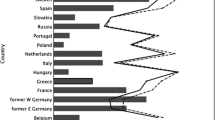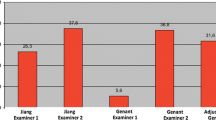Abstract:
Morphometric methods have been developed for standardized assessment of vertebral deformities in clinical and epidemiologic studies of spinal osteoporosis. However, vertebral deformity may be caused by a variety of other conditions. To examine the validity of morphometrically assessed vertebral deformities as an index of osteoporotic vertebral fractures, we developed an algorithm for radiological differential classification (RDC) based on a combination of quantitative and qualitative assessment of lateral spinal radiographs. Radiographs were obtained in a population of 50- to 80-year-old German women (n= 283) and men (n = 297) surveyed in the context of the European Vertebral Osteoporosis Study (EVOS). Morphometric methods (Eastell 3 SD and 4 SD criteria, McCloskey) were validated against RDC and against bone mineral density (BMD) at the femur and the lumbar spine. According to RDC 36 persons (6.2%) had at least one osteoporotic vertebral fracture; among 516 (88.9%) nonosteoporotics 154 had severe spondylosis, 132 had other spinal disease and 219 had normal findings; 14 persons (2.4%) could not be unequivocally classified. The prevalence of morphometrically assessed vertebral deformities ranged from 7.3% to 19.2% in women and from 3.5% to 16.6% in men, depending on the stringency of the morphometric criteria. The agreement between RDC and morphometric methods was poor. In men, 62–86% of cases with vertebral deformities were classified as nonosteoporotic (severe spondylosis or other spinal disease) by RDC, compared with 31–68% in women. Among these, most had wedge deformities of the thoracic spine. On the other hand, up to 80% of osteoporotic vertebral fractures in men and up to 48% in women were missed by morphometry, in particular endplate fractures at the lumbar spine. In the group with osteoporotic vertebral fractures by RDC the proportion of persons with osteoporosis according to the WHO criteria (T-score <−2.5 SD) was 90.0% in women and 86.6% in men, compared with 67.9–85.0% in women and 20.8–50.0% in men with vertebral deformities by various methods. Although vertebral deformities by most definitions were significantly and inversely related to BMD as a continuous variable in both sexes [OR; 95% CI ranged between (1.70; 1.07–2.70) and (3.69; 1.33–10.25)], a much stronger association existed between BMD and osteoporotic fractures defined by RDC [OR; 95% CI between (4.85; 2.30–10.24) and (15.40; 4.65–51.02)]. In the nonosteoporotic group individuals with severe spondylosis had significantly higher BMD values at the femoral neck (p <0.01) and lumbar spine (p <0.0004) compared with the normal group. On the basis of internal (RDC) and external (BMD) validation, we conclude that assessment of vertebral osteoporotic fracture by quantitative methods alone will result in considerable misclassification, especially in men. Criteria for differential diagnosis as used within RDC can be helpful for a standardized subclassification of vertebral deformities in studies of spinal osteoporosis.
Similar content being viewed by others
Author information
Authors and Affiliations
Additional information
Received: 5 February 1999 / Accepted: 24 June 1999
Rights and permissions
About this article
Cite this article
Leidig-Bruckner, G., Limberg, B., Felsenberg, D. et al. Sex Difference in the Validity of Vertebral Deformities as an Index of Prevalent Vertebral Osteoporotic Fractures: A Population Survey of Older Men and Women . Osteoporos Int 11, 102–119 (2000). https://doi.org/10.1007/PL00004172
Issue Date:
DOI: https://doi.org/10.1007/PL00004172




